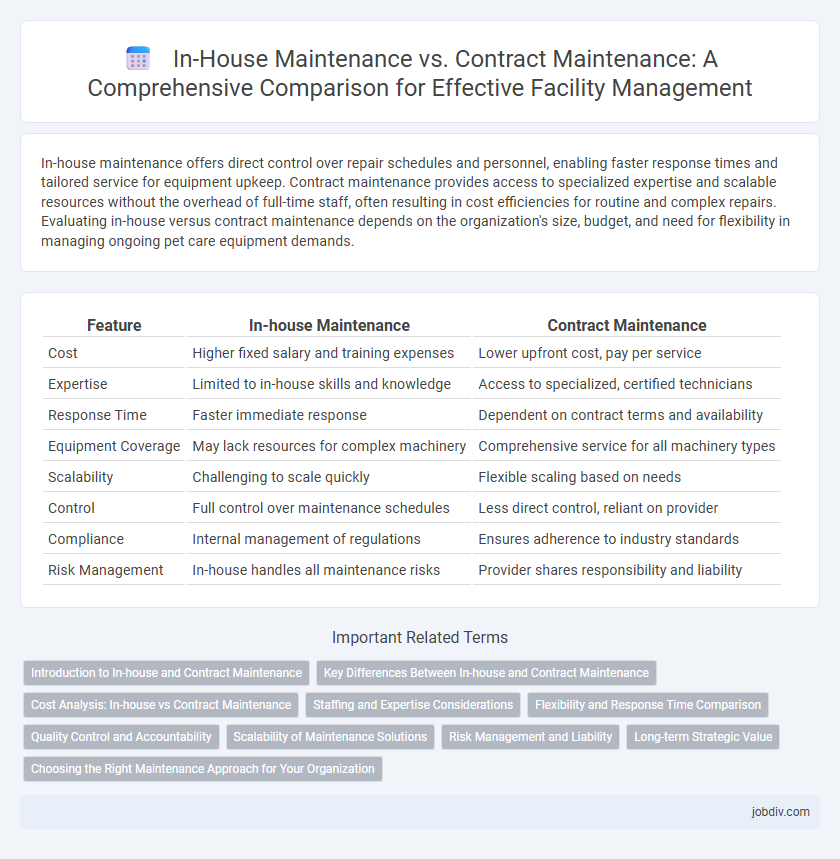In-house maintenance offers direct control over repair schedules and personnel, enabling faster response times and tailored service for equipment upkeep. Contract maintenance provides access to specialized expertise and scalable resources without the overhead of full-time staff, often resulting in cost efficiencies for routine and complex repairs. Evaluating in-house versus contract maintenance depends on the organization's size, budget, and need for flexibility in managing ongoing pet care equipment demands.
Table of Comparison
| Feature | In-house Maintenance | Contract Maintenance |
|---|---|---|
| Cost | Higher fixed salary and training expenses | Lower upfront cost, pay per service |
| Expertise | Limited to in-house skills and knowledge | Access to specialized, certified technicians |
| Response Time | Faster immediate response | Dependent on contract terms and availability |
| Equipment Coverage | May lack resources for complex machinery | Comprehensive service for all machinery types |
| Scalability | Challenging to scale quickly | Flexible scaling based on needs |
| Control | Full control over maintenance schedules | Less direct control, reliant on provider |
| Compliance | Internal management of regulations | Ensures adherence to industry standards |
| Risk Management | In-house handles all maintenance risks | Provider shares responsibility and liability |
Introduction to In-house and Contract Maintenance
In-house maintenance involves a dedicated team within the organization responsible for equipment repairs, preventive upkeep, and system checks, ensuring direct control over maintenance schedules and quality. Contract maintenance outsources these tasks to specialized service providers, offering flexibility, access to expert technicians, and cost efficiency for non-core activities. Choosing between in-house and contract maintenance depends on factors like company size, technical complexity, and budget constraints.
Key Differences Between In-house and Contract Maintenance
In-house maintenance involves a dedicated team of employees handling equipment repairs and preventive tasks within an organization, ensuring quick response times and direct control over operations. Contract maintenance outsources these tasks to external specialists, offering cost savings on labor and flexibility for varying workload demands, often bringing specialized expertise that may not be available internally. Key differences include control level, cost structure, response time, and scalability, with in-house systems favoring consistent, ongoing support while contract models provide adaptability and access to advanced skill sets.
Cost Analysis: In-house vs Contract Maintenance
In-house maintenance often incurs fixed costs such as salaries, training, and equipment acquisition, leading to higher initial expenditures but more control over operational efficiency. Contract maintenance typically involves variable costs based on service agreements, which can reduce capital outlay and offer scalability but may introduce hidden fees and less direct oversight. Analyzing total cost of ownership reveals that in-house maintenance suits organizations with consistent, high-volume needs, while contract maintenance provides cost benefits for fluctuating workloads and specialized expertise.
Staffing and Expertise Considerations
In-house maintenance requires a dedicated team with specialized skills aligned to the organization's specific equipment and processes, offering immediate responsiveness and deep institutional knowledge. Contract maintenance provides access to a broader range of expertise and advanced technologies without the overhead of full-time staff, allowing for scalable support during peak demands or specialized projects. Balancing costs, skill availability, and response times is critical when deciding between maintaining an internal workforce or outsourcing to external maintenance providers.
Flexibility and Response Time Comparison
In-house maintenance provides higher flexibility with direct control over scheduling and immediate adjustments to changing operational needs. Contract maintenance often experiences longer response times due to reliance on external providers and predefined service level agreements. Companies prioritizing rapid response and adaptive maintenance strategies tend to favor in-house teams for critical infrastructure support.
Quality Control and Accountability
In-house maintenance offers direct control over quality standards and immediate accountability through dedicated staff familiar with the specific operational environment. Contract maintenance relies on external vendors who may bring specialized expertise but can face challenges in enforcing consistent quality control and timely responsibility. Implementing clear performance metrics and regular audits is essential to maintain accountability across both maintenance models.
Scalability of Maintenance Solutions
In-house maintenance offers limited scalability due to fixed personnel and resource constraints, making it challenging to adapt quickly to fluctuating maintenance demands. Contract maintenance provides scalable solutions by leveraging external expertise and flexible workforce availability, enabling rapid response to varying workload intensities. Businesses seeking growth flexibility often prefer contract maintenance for its ability to efficiently scale operations without significant capital investment.
Risk Management and Liability
In-house maintenance allows organizations to retain direct control over risk management protocols and liability, ensuring immediate response and customized safety measures aligned with company standards. Contract maintenance transfers responsibility to third-party providers, potentially reducing internal liability but necessitating rigorous vetting and clear contractual terms to mitigate risks associated with third-party management. Effective risk management in both models depends on thorough documentation, compliance with industry regulations, and precise definition of liability clauses to avoid operational disruptions and legal exposure.
Long-term Strategic Value
In-house maintenance offers companies direct control over asset management, fostering deep institutional knowledge and enabling rapid response to equipment issues, which contributes to consistent operational efficiency over time. Contract maintenance provides scalability and access to specialized expertise, reducing overhead costs and allowing businesses to focus on core activities while leveraging vendor innovation and updated technology. Evaluating the long-term strategic value requires balancing the benefits of internal workforce investment against the flexibility and potentially lower total cost of outsourcing maintenance functions.
Choosing the Right Maintenance Approach for Your Organization
Selecting the right maintenance approach depends on factors such as budget, resource availability, and technical expertise. In-house maintenance offers direct control and faster response times, ideal for organizations with skilled staff and frequent equipment needs. Contract maintenance provides cost savings, access to specialized skills, and scalability, making it suitable for companies seeking flexibility and reduced overhead.
In-house Maintenance vs Contract Maintenance Infographic

 jobdiv.com
jobdiv.com